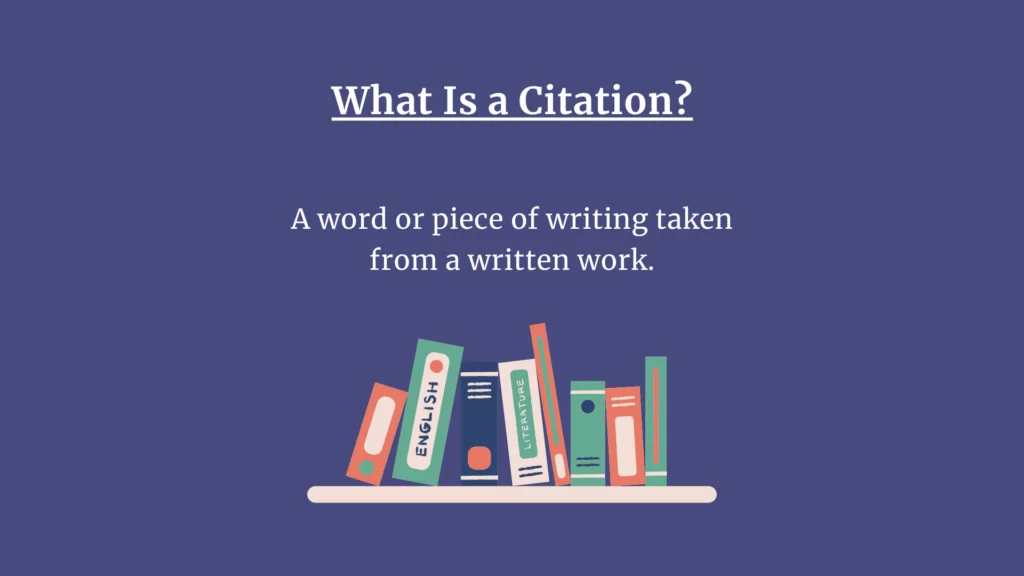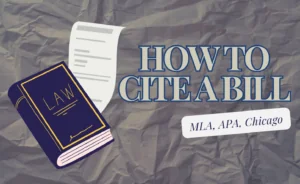When starting your first research work, you will find that citations play one of the central roles in building originality, credibility, and respect for both your work and intellectual property in general. Understanding what a citation is and how to use it effectively is fundamental for anyone engaging in scholarly writing.

✅ AI Essay Writer ✅ AI Detector ✅ Plagchecker ✅ Paraphraser
✅ Summarizer ✅ Citation Generator
Definition of a Citation
A citation is a formal reference to a source from which information or ideas have been drawn. It is a way to credit the original author and to provide the readers with the necessary information to find the source themselves. Citations are vital in academic writing as they lend support and credibility to the writer’s own ideas and arguments, and they can be created via a free citation generator.

The Role of Citations in Scholarly Work
Creating citations is an inseparable part of academic writing, primarily serving as a guard against the unethical practice of plagiarizing. Plagiarism is the act of using another person’s work or ideas without giving them due credit, and it is considered a serious offense in the academic world. Citing sources demonstrates that writers respect the original author’s intellectual property and acknowledge their contribution to the field.
Moreover, citations illustrate that the writer has engaged in extensive research, adding depth and credibility to their work. They act as a roadmap, allowing readers to follow the trail of research and thought processes that led to the conclusions drawn in the paper. This transparency contributes to the audience’s understanding and allows them to verify the data and ideas presented, making sure the integrity and reliability of the scholarly discourse. Therefore, citations are essential to maintaining the honesty and trustworthiness of academic communication.
Types of Citations
Understanding the different types of citations is key to crafting well-researched and credible work. Each citation style, whether it’s APA, MLA, or Chicago, serves a specific purpose and follows distinct guidelines that build clarity and uniformity in academic communication. From in-text citations that subtly acknowledge sources within your narrative, to detailed bibliographies that offer a comprehensive overview of your research, mastering these various forms enhances the integrity and impact of your writing.
In-text Citations
In-text citations are integral to most academic writing formats. An example of an in-text citation in APA style is:
> (Smith, 2020).
This format briefly acknowledges the source within the text, typically featuring the author’s last name and the publication year. The purpose of in-text citations is to point the reader towards the more detailed reference list entry, allowing them to easily locate the full source details without cluttering the main text with extensive information.
Reference List Citations
Reference list citations are found at the end of an academic paper and provide comprehensive details about each source. For instance, a typical APA reference list entry might look like:
> Smith, J. (2020). Title of the Work. Publisher.
This format includes the author’s name, publication year, title of the work, and publisher details. The reference list ensures that every source mentioned in the in-text citations is accounted for, with sufficient information for the reader to find the original work.
Footnotes and Endnotes
Footnotes and endnotes serve as supplemental tools for citations or additional comments. An example of a footnote in Chicago style might appear as a superscript number within the text, with the corresponding note at the bottom of the page:
> ¹Smith, Title of the Work, 45.
Footnotes are found at the bottom of the page where the reference is made, while endnotes appear collectively at the end of the chapter or document. They can include full citation details or additional insights related to the content, providing further depth and context to the main text.
Citation Styles and Formats
| Name of Style | Short Description | Example |
|---|---|---|
| APA (American Psychological Association) | Used in psychology and other social sciences, emphasizing dates of publications. | Smith, J. (2020). Understanding Cognitive Behaviors. Psychology Today Press. |
| MLA (Modern Language Association) | Common in the humanities, focusing on author-page format for in-text citation. | Smith, John. “Narrative Structures.” Literary Explorations, vol. 47, no. 3, 2020, pp. 45-67. |
| Chicago Style | Offers two systems – Author-Date and Notes-Bibliography, widely used in history and other disciplines. | Smith, John. 2020. Historical Analysis. Chicago: History Press. |
| Harvard | Similar to APA but with minor differences in punctuation and formatting. | Smith, J. (2020) Economic Theories Reviewed. New York: Economic Press. |
| Vancouver | Numerical style used in physical, life, and medical sciences. | Smith J. Economic Theories Reviewed. New York: Economic Press; 2020. |
| IEEE (Institute of Electrical and Electronics Engineers) | Predominantly used in technical fields, relying on numbered citations in the text. | [1] J. Smith, “Wireless Technologies,” in Modern Communication Systems, New York, NY, USA: TechPress, 2020, ch. 5, pp. 101-123. |
| AMA (American Medical Association) | Common in medical publications, using a numerical system of citation. | 1. Smith J, Johnson B. Recent Developments in Cardiology. New York, NY: MedPress; 2020. |
Common Issues and Mistakes in Citation
In the world of academic writing, navigating the intricacies of citation can often be challenging, and it’s all too easy to stumble into common pitfalls. Incorrect citation format is a frequent error, where writers might mix up the requirements of different citation styles, such as confusing APA with MLA. This can lead to confusion and misinterpretation of the source material. Another common issue is missing information in citations, like omitting the publication date or the publisher’s name. This lack of detail can make it difficult for readers to locate the original sources, thereby affecting the paper’s reliability.
Inconsistency in citation styles throughout a document is another area where writers often err. For instance, using APA style in one section and then inadvertently switching to Chicago style in another can create a disjointed reading experience. Such inconsistencies not only disrupt the flow of your writing but also question its scholarly rigor. To maintain the integrity and credibility of your work, it is crucial to be thorough and consistent in your citation practices, carefully adhering to the rules of the chosen citation style. Remember, in the realm of academic writing, precision, and attention to detail in citations are as important as the content itself.
Conclusion
Citations are more than just formalities. They are a testament to a writer’s integrity, attention to detail, and engagement with the scholarly community. Proper citation practices honor the originality of ideas while building a reliable and verifiable body of knowledge. As such, mastering the art of citation is a key skill in academic writing.
FAQ
Follow us on Reddit for more insights and updates.





Comments (0)
Welcome to A*Help comments!
We’re all about debate and discussion at A*Help.
We value the diverse opinions of users, so you may find points of view that you don’t agree with. And that’s cool. However, there are certain things we’re not OK with: attempts to manipulate our data in any way, for example, or the posting of discriminative, offensive, hateful, or disparaging material.